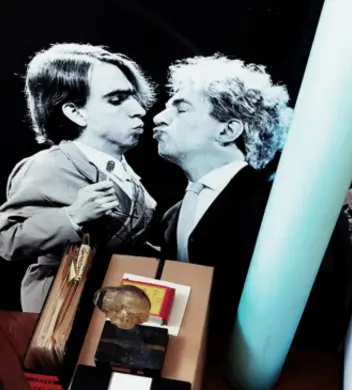WOLF WOLF opens the NTGent archive with Nooit Nooit

If we are to believe their name, WOLF WOLF isn’t afraid of repetition. The theatre collective makes repertoire from repertoire: with Voorjaarsontwaken, they adapted Frank Wedekind’s classic, while Dromers was inspired by Bertolucci’s The Dreamers. In their newest creation - baptised Nooit Nooit - it’s as if they are taking a different approach. Instead of starting from one literary source, they now draw from the space in which those sources are stored - namely, an archive. Right before the start of rehearsals, we spoke with Naomi van der Horst and Mitch Van Landeghem about how Nooit Nooit came to be, about how WOLF WOLF relates to repertoire, and about repetition and style. Above all, we talked about the power of fiction, and of theatre in general.
Let’s start at the beginning. How did you come up with the idea for this production?
Naomi: It’s a confluence of circumstances. After the creation of Dromers in December 2023, we had already once considered the idea of not starting from a text, but from scenography: a place, a space, or a concrete materiality. And last year, NTGent approached us, asking if we would like to create a theatre piece for them. For this, they offered us their archive.
Mitch: Additionally, this year marks our fifth anniversary; it would be our fifth production, there are five of us in WOLF WOLF, and NTGent is also celebrating its sixtieth birthday. All in all, enough reason to do something big. The idea of working with something as endless as a theatre archive really brought everything together.
Naomi: The archive provides us with a very concrete angle, yet it is also the most abstract and grand material we have ever worked with. Normally, we always started from one core material: one book, one movie, one theatre text. This time, though, we started from the conceptual spatiality of ‘the archive’ - or more specifically, ‘the theatre archive’ - as repository of those very core materials.
Mitch: The original plan was to make something about ‘the archive’ using ‘the archive’. We would utilise every piece of material found there - texts, costumes, sets - as possible building blocks.
<img class="editorial-image" src="https://cdn.prod.website-files.com/61eebcc683107b99137f4423/68e7a4474059845c1bb2da0a_WOLFWOLF_BysterkendriesMayli-8072spread.avif"/>
A collage performance?
Mitch: Yes, but the more time we spent in there, the more we became interested in the concept of an archive itself - the associations it evokes, the metaphors it brings up.
Naomi: Remembering, forgetting, retaining… The fact that the NTGent archive is going to be digitised added another layer. To make the gesture even grander, Mitch at one point suggested that we learn the entire archive by heart.
Mitch: Theatre then functions as an emotional or abstract version of archiving. And no one can take it away from you. That’s what I like about it. If you’ve learned something by heart, it’s yours. At the same time, if you’re no longer around, if you forget it, it’s gone - and so this idea is just as remarkable as it is fragile.
Naomi: Through the archive, we are confronted with limits. How much can we remember, how much can we keep? Archives have something romantic, because they deal with issues as remembrance, loss and dissolution. The space really triggers our imagination.
<img class="editorial-image-50-left" src="https://cdn.prod.website-files.com/61eebcc683107b99137f4423/68e7a4466a8cf1abbabbea70_WOLFWOLF_BysterkendriesMayli-.avif"/>
<img class="editorial-image-50-right" src="https://cdn.prod.website-files.com/61eebcc683107b99137f4423/68e7a446969b05d2bab021a3_WOLFWOLF_BysterkendriesMayli-8039.avif"/>
Is Nooit Nooit then becoming the most personal performance you’ve ever made? Unlike in your other works, there aren’t really prescribed characters here. Normally, those characters also play themselves. Are you playing yourselves now?
Naomi: I think we believe too strongly in the power of fiction for that to be the case. Of course, there’s always something personal in every character, but when performing, we really want to dive into a different world.
Mitch: It’s important for us to maintain a distance from the characters we play. Only in this way can we do whatever we want with them; anything can happen, we don’t have to be careful. At the same time, I do think your question touches upon something. Because the funny thing is that we’re constantly looking for a performance style that does make you believe that it is really us, that we are really ourselves.
Naomi (laughs): Yes, In fact, we misuse the characters. We misuse fiction.
<img class="editorial-image-50-left" src="https://cdn.prod.website-files.com/61eebcc683107b99137f4423/68e7a44671c7802b7b90ce32_WOLFWOLF_BysterkendriesMayli-7888.avif"/>
<img class="editorial-image-50-right" src="https://cdn.prod.website-files.com/61eebcc683107b99137f4423/68e7a4463ddac72a9d381878_WOLFWOLF_BysterkendriesMayli-7885.avif"/>
In what way, and for what purpose?
Naomi: To be able to pretend it’s all real.
Mitch: And to say something about the world and ourselves. We reach for stories to escape reality… but in doing so, we still end up talking about it.
Naomi: Through fiction, we practice life. Theatre is a shared playing of a game to get to know ourselves and each other.
Mitch: In that sense, Nooit Nooit isn’t any different from our previous work. What we do hasn’t changed since we did Who’s Afraid of Virginia Woolf?. We begin in a rehearsal room and try to get everyone on board with a story. This story is actually very far from us, but we still try to easily slide into it. I think that’s what we’ll try to do now too - without Nooit Nooit becoming a second Voorjaarsontwaken or Dromers.
<img class="editorial-image-50-left" src="https://cdn.prod.website-files.com/61eebcc683107b99137f4423/68e7a446d517a467fac5328d_WOLFWOLF_BysterkendriesMayli-7907.avif"/>
<img class="editorial-image-50-right" src="https://cdn.prod.website-files.com/61eebcc683107b99137f4423/68e7a4468723478c67ff5170_WOLFWOLF_BysterkendriesMayli-8057.avif"/>
Do you feel that with this production - since it starts from a different premise - you are moving beyond merely repetition (of repertoire), and are really finding your ‘style’?
Naomi: I do notice that certain themes keep coming back… Escaping through fiction. The need for fiction as humans. Without it, we wouldn’t be able to cope with reality.
Mitch: In that sense, I feel… that through this project and via the archive, we are really learning something about theatre itself. About what it means to relate to repertoire. For example, I really hoped that at some point we’d find ‘the piece’, and with the idea of the performance being about archiving, that piece would suddenly mean so much more. But that’s not how theatre works.
Naomi: If you pull something from the archive, if you isolate one scene… It’s nothing on its own. That’s how it is with theatre: things that you think work on paper never really work in real life.
Mitch: Indeed, it apparently doesn’t work like that with theatre texts, that you can make a ‘Best Of’ out of existing scenes, good scenes. You need context. You need context to understand why something is a good scene. To know if something is valuable, it has to fit within a context. Similarly, the archival material needs to fit within our context.
<img class="editorial-image" src="https://cdn.prod.website-files.com/61eebcc683107b99137f4423/68e7a446cb29b094fec9c4f4_WOLFWOLF_BysterkendriesMayli-7926.avif"/>
Is an archive capable of preserving work, or does archiving theatre pieces require a different form? As long as the texts from the archive aren’t performed, aren’t lived, they remain unprocessed, and can’t be truly valued?
Naomi: It’s as they always say: get on stage as quickly as possible. Try things out. That’s why I’m so curious about where Nooit Nooit is going to take us.
<div class="editorial-banner"> <div class=“editorial-credits”>@wolfwolfcollectief</div></div>
Different Class works with the interest of their community at heart.
Our work’s purpose is to foster a solid network for independent artists, those who love them, and those who want to support them. Become a member to contribute to the local Belgian art scene.







